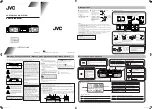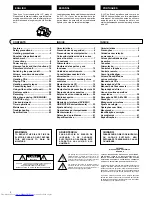
Manual-2
GRAPHIC
EQUALIZER
6
3
3
6
∞
6
∞
6
20k
7k
14k
5k
10k
15
120
30
240
60
∞
6
∞
6
20k
7k
14k
5k
10k
15
120
30
240
60
6
3
3
6
•
•
•
•
•
•
•
•
+6
-12
-6
-3
0
+3
+12 OL
+6
-12
-6
-3
0
+3
+12 OL
0
+
0
+
12
12
12
12
12
12
12
12
+
+
0
+
0
+
0
0
+
+
0
+
0
+
0
0
±6
±6
5.0k
25
31.5
40
50
63
80
100
800
125
160
200
250
500
400
315
630
2.0k
1.25k
1.0k
1.6k
3.15k
2.5k
4.0k
12.5k
8.0k
6.3k
10k
16k
20k
LOW
MID
HIGH
LOW HIGH
IN
OUT
POWER
B
EQ
EQ
PROPORT-Q
OUT
IN
PERFECT-Q™
BYPASS
A
±12
CUT FILTERS
TONE
LEVEL
DEQ 60
A
B
A
B
B
PROPORT-Q
OUT
IN
PERFECT-Q™
BYPASS
A
±12
12
6
6
12
12
6
6
12
+
0
+
0
•
•
•
•
•
•
•
•
1
2
3
4
10
9
5 6 7 8
햲
Graphic EQ controls: Thirty bands of EQ are provided for each channel. Each EQ slider has a resolution of 256 steps. The
center detent position guarantees a flat response. Slide control travel is 25 mm. Comfortable, easy to read, soft touch knobs
are provided.
햳
LOW, MID, and HIGH TONE controls: Independent, Accelerated-slope™, 3-band Tone controls allow easy, intuitive
adjustment of tone response without the hassle of adjusting 30 bands. The Tone controls use 12 dB per octave Linkwitz-
Riley filters. The Low/Mid crossover point is 300 Hz. The Mid/High crossover point is 4 kHz. As with the EQ sliders,
center detent provides a guaranteed flat response. The range of control is +6 dB to off. Control resolution is 256 steps.
햴
LOW CUT and HIGH CUT FILTERS: The LOW Cut Filter is adjustable over four octaves in 64 steps with a frequency
range of 15 Hz to 240 Hz. The HIGH Cut Filter is adjustable over two octaves in 64 steps from 5 kHz to 20 kHz.
햵
LEVEL controls serve two purposes, when used with the Meters (
햺
):
1) Adjust the INPUT signal level to 0 dBu for good headroom and signal to noise.
2) Compensate for changes in signal level due to filter boost/cut settings by adjusting the OUTPUT signal level to 0 dBu.
The operation of the OUTPUT LEVEL control is reversed. Pushing the control up reduces gain. Pushing the control down
increases the gain. This allows the user to easily adjust sensitivity without affecting the output signal level. Simply grasp
both input and output controls and move together. The ranges of both controls is ±12 dB with a resolution of 256 steps.
햶
BYPASS switches have two possible modes of operation. If the rear panel switch is set to BYPASS ALL, all filters and
level controls are bypassed. If the rear panel switch is set to BYPASS FILTERS, only the filters are bypassed. Filters
include EQ, TONE and CUT. Automatic relay bypass hardwires Inputs to Outputs in the event of a power failure.
햷
A / B switches determine which set of controls is used by the A-Channel or B-Channel. Controls affected by the A / B
switch are EQ, TONE, CUT FILTERS, LEVEL, Q switches and ±12 / ±6 dB switches. Bypass switches are not affected.
햸
PERFECT-Q™: What you see is what you get. PROPORTional-Q: Classic smooth response. Most users will prefer this
switch in the PERFECT-Q position. Some users may prefer the PROPORT-Q setting. See Graphic EQ Controls on page
Manual-4.
햹
±12 / ±6 dB switch changes the boost cut of the Graphic EQ (
햲
) for each Channel. Use the ±6 dB unless you really need
±12 dB, the resolution is better.
햺
Input and Output Meters are peak responding and indicate the signal level in dBu. Peak-dBu is held and displayed for 1.5
seconds. Attack is instantaneous. Decay is 500 ms for a 20 dB step.
햻
When the POWER indicator is on, it indicates that power is turned on. This works with
햵
on the Rear Panel (next page).
FRONT PANEL DESCRIPTION






















